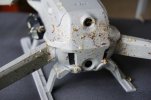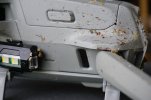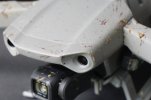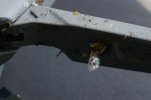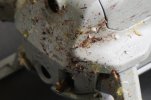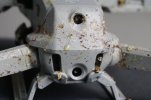D
You are using an out of date browser. It may not display this or other websites correctly.
You should upgrade or use an alternative browser.
You should upgrade or use an alternative browser.
Bee devilled
- Thread starter Drone alone.
- Start date
There probably is some footage of the event but I haven't looked yet. More concerned with getting my drone cleaned up and out flying again. I did go higher with the drone and also accelerated away from the swarm,but I was restricted to how far I could go in the park to take evasive action. The bees were very determined.I've used Q-Tips and Sprayway World's Best Glass Cleaner. Maybe's it's not the best for it but it worked fine.
EDIT: Did you get footage of this bee swarm? Wonder what would happen if you went higher.
Will post a photo shortly in answer to your question. I think the bees were the normal Western Australian honey bee. They are not normally aggressive.Drone alone, do you have a photo of the tails?
Humming birds also attack them.
Do you know why hummingbirds hum?
They don't know the words.
.
D
Deleted member 103366
Guest
hmmmmmmThey don't know the words.
If you had used Bees Wax before flight it would come off easier!Gooday all,
Yesterday I was able to get out and fly my Mavic air 2 in a local park for the first time in a couple of weeks[due severe winter storms with wind gusts up to 100klm's per hour]
I had launched the drone with everything in and locked, weather was sunny with very little wind.
I had been flying within the surrounds of the park at about a height of 30 metres for about 10 minutes when I noticed a darkish cloud forming around the drone. I then realised my drone was being attacked by a large swarm of aggressive bees. I immediately ascended to about 50-60 metres but the swarm still persisted converging on the drone, so I descended down to about 10 metres to a point where the bees started to lose interest. I decided it better to call it a day right then and there and successfully landed my drone on the pad. After engine shutdown, I picked up my air 2 and could not believe the state that it was in. Every part of the drone front and rear was covered in bee detritus,heads wings tails and a sticky residue.What most concerns me is that a lot of the sensors have this stuff stuck in the surrounding crevices.
My question is, how do I clean up the drone and dispense with all this sticky litter etc without getting fluid/water ingress into the electrical compartments and fluid sensitive areas.
I have had to discard the props,as all the leading edges will have been damaged by the bee parts slamming into them.
Any help or advice will be appreciated. As you can imagine I am pretty distraught at the condition of my drone and I honestly don't know where to start the cleanup.
Thanks Phil.
More like get up and go do some work, ha ha. L
Do it even work like that?If you had used Bees Wax before flight it would come off easier!
- Joined
- May 25, 2017
- Messages
- 8,476
- Reactions
- 7,966
- Age
- 63
If you had used Bees Wax before flight it would come off easier!
A ceramic coating would certainly help, very much so.
Mothers CMX Ceramic Spray Coating (1st product) is available Worldwide (afaik) brilliant on almost any surface, auto, caravan, shower screens.
Even suds at the carwash just falls off it.
Hi MA2 317Sounds like you were in Class Bee Airspace.
I've read that baby wipes are good for cleaning the bug juice from the aircraft.
Leaves it smelling nice too.
.
Thank you for your suggestion re the baby wipes. They worked really well,getting most of the bee carcasses and sticky residue off the main body of the drone. had a bit of fiddling with toothpicks and tweezers to get the bits lodged in the crevices i.e the swing arm joints etc But now my drone is looking as new again. Will install another set of props and give it a fly. Thanks again. Phil.
D
Deleted member 103366
Guest
Yes mate have taken some photos.Will post asap. props are pretty much had the bomb. tried to clean them up but leading edges are chipped after hitting so many bees. Considering the crud on the propellors, I think I was lucky to get it back on the ground safely. Like a build up of ice on a jet' wings,making for clumsy control.Did you get the photos?
Why replace the propellors? Were they damaged?
Jagerbomb52
Well-Known Member
Funny after a lot of response I decided to google it LOL

 droneflyingpro.com
droneflyingpro.com

Why do bees attack drones? [Videos and cleaning tips]
Why do bees attack drones? Well there's a whole bunch of signals that drones give out that tell bees that they could be a threat - here we look at them all!
 droneflyingpro.com
droneflyingpro.com
Thanks for that interesting info Agustine. That is pretty much how it all happened. Fortunately I was able to get my drone back on the ground,but boy what a cleanup required.Funny after a lot of response I decided to google it LOL

Why do bees attack drones? [Videos and cleaning tips]
Why do bees attack drones? Well there's a whole bunch of signals that drones give out that tell bees that they could be a threat - here we look at them all!droneflyingpro.com
Jagerbomb52
Well-Known Member
Well after flying since 2015 with serval different brands of drones I find the foldable ones to attract bugs in general most. Think it is the higher pitch sound. During the summer nights around here in Northern Ontario mosquitoes become victims to the blade gods. One of my bigger quads has carbon fiber blades and it chews them up pretty good but leaves a big mess to clean up. My two Anafi's attract humming birds but so far no actual hits by one of them which is good as they would take down the drone by stopping the blades.
Just trying to be funny. Bug guts on drone suck, be they bees, beetles or skeeters.Mate my thoughts were also for the bees,but there was no sign of them when I launched the drone. I always have a good look around the area before flying,looking for aggressive people dogs birds etc. If there is any doubt I pack up and leave.
D
Deleted member 103366
Guest
Blimey what a mess.See photos.
Unfortunately your drone has done a very good job of dicing the bees and I can't see, with certainty, the details that I was hoping to.
Here, UK, Worker Honey Bees (female) have pointed rear ends, male Honey Bees (Drones) are noticably larger than workers in all areas of their bodies and have blunt rear ends. Drones are used for only on purpose, the obvious one.
I asked about this because in one video, shot by the drone under 'attack', the 'attackers' were visibly males.
Only females have stingers https://ucanr.edu/blogs/bugsquad//blogfiles/20982_original.jpg
Last edited by a moderator:
Yes mate,the poor 'ol bees were certainly sliced and diced. I was very careful to wear gloves when stating my cleanup attempt to avoid getting a sting. I'm pretty sure these were worker bees due to their size.Blimey what a mess.
Unfortunately your drone has done a very good job of dicing the bees and I can't see, with certainty, the details that I was hoping to.
Here, UK, Worker Honey Bees (female) have pointed rear ends, male Honey Bees (Drones) are noticably larger than workers in all areas of their bodies and have blunt rear ends. Drones are used for only on purpose, the obvious one.
I asked about this because in one video, shot by the drone under 'attack', the 'attackers' were visibly males.
Only females have stingers https://ucanr.edu/blogs/bugsquad//blogfiles/20982_original.jpg
Similar threads
- Replies
- 22
- Views
- 3K
- Replies
- 28
- Views
- 2K
- Replies
- 8
- Views
- 1K
DJI Drone Deals
New Threads
-
-
-
DJI Mini 4 Pro Fly More (with RC 2 Remote) USA, DJI Wide Angel & CPL Filter
- Started by Dogpilot
- Replies: 2
-
What You Should Know About The Antigravity A1-360 Drone.
- Started by The Droning Company
- Replies: 1
-
Drones Capture Video of Washington State Floods.
- Started by The Droning Company
- Replies: 1
Members online
Total: 3,751 (members: 6, guests: 3,745)




